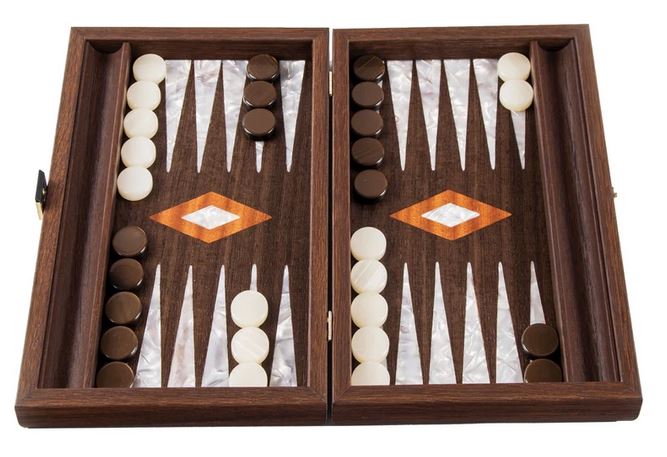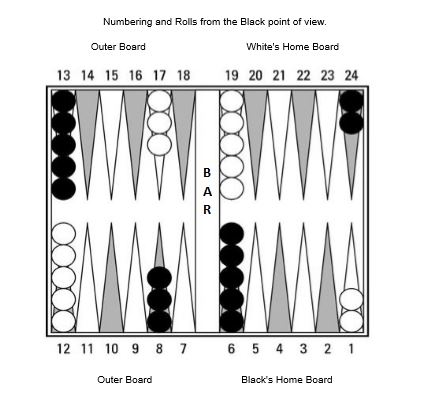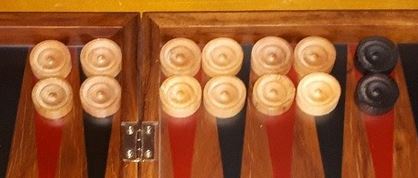Last updated on July 24, 2025
In this Deluxe Backgammon post, we list the ten most common questions we are asked about the rules of play. We usually play in local cafes or pubs, invariably, someone will stop by and watch a game and comment. They nearly always remember the game from their youth and ask questions to refresh their memory.
What equipment do I need to play?
1. A backgammon board.
2. Thirty checkers in two different colours, fifteen of the same colour for each player.
3. A pair of dice numbered from 1 to 6. Ideally, for convenience, two pairs of dice (one pair for each player).
4. A dice cup, for rolling the dice. Ideally, it is better to have two dice cups.
5. A doubling cube for keeping track of the stakes of the game.
How do you set up the board?
Remembering how to set up a backgammon board is easy to forget, hence it is one of our common questions. The screenshot below shows the setup when you are playing white and your checkers move counter-clockwise around the board. The brown checkers move in the opposite direction. Both players bear off to the right, you at the lower-right, your opponent at the upper-right (How to set up a backgammon board at The Spruce Crafts).
Who goes first?
To decide who goes first, each player rolls one die. In the case of a tie, both players roll again. The player who rolls the higher number goes first. That player does not roll the dice again. They play the two numbers just rolled on the dice. Note that the player who goes first never has doubles on their first move because ties on the dice rolls are always rerolled. The first player has a slight statistical advantage in backgammon.
What is the mid-point?
The mid-point is the name of the point on your opponent’s side of the board where you have a stack of five checkers at the start of the game. It is also known as the 13-point, as per the screenshot below. This is because the checkers on that point are 13 points away from being borne off. The opponent’s mid-point is your 12-point (Mid-point at Backgammon Galore).
What is the ace-point?
The ace-point is another name for the 1-point, the last point the checkers can occupy before bearing them off. The screenshot above shows the ace-point for the black checkers labelled with the number 1. At the start of play, your two back checkers begin on the opponent’s ace-point (Ace point at the USBGF).
Can you have more than five checkers on a point?
The simple answer is yes. You can place as many checkers as you wish on a single point. It is perfectly legal to stack all fifteen of your checkers on a single point, although it won’t help flexible play. There was a version of backgammon popular in England which allowed no more than five checkers on a point. This was known as Old English backgammon, but these are not standard rules.
What does it mean to secure a point?
To make or secure a point, you need to move two or more checkers together onto the same point. That point is now secure, and consequently, your opponent may not land on the point as long as two or more of your checkers remain. A prime refers to a series of points placed side by side. The ideal prime is a 6-prime, which creates an impassable barrier to your opponent’s checkers (How to secure a point at Backgammon Galore).
What is the home board?
The home and outer boards are separated from each other by a ridge down the centre of the board called the bar. Your home board is the last quadrant that you move your checkers to before bearing them off. The opponent’s home board is where you enter your checkers after they have been hit. In the diagram below, the black home board is in the bottom right-hand corner. The white home board is in the top right-hand corner. The black outer board is on the bottom left. The white outer board is on the top left.
If I don’t like the dice roll, can I skip my turn?
No, you must play your roll in its entirety if there is any legal way to do so. If you can’t play all of your numbers, you must play as many as you can. For example, if you roll 5-5 and can only play three of your four 5’s, that is what you must do. Additionally, you must play both numbers of a roll if possible. Sometimes, this means making a move you don’t like to ensure both numbers can be played. Finally, if you can only play one number, but not both, then you must play the higher one.
What is a closed board?
A player who forms a 6-prime in their home board is said to have created a closed board. If an opposing checker is sitting on the bar it will be unable to re-enter into the closed board. Consequently, the checker will be unable to re-enter until one or more of the points in the closed board are opened.
Do you have to roll the exact number to bear off in backgammon?
No. The rules regarding bearing off are:
- You can bear off a checker by rolling a number that corresponds to the point on which that checker occupies. When you roll a 4, for example, you can bear off a checker from the 4-point.
- If there is no checker on the point indicated by the roll, you must make a legal move using a checker on a higher-numbered point. When there are no checkers on higher-numbered points, you must remove a checker from the highest point occupied by one of your pieces.
- If you can make a legal move, you don’t have to bear off.
- If one of your checkers is hit as you’re bearing off, you must re-enter that checker and move it back into the home board before you can resume bearing off.
Summary
Hopefully, these ten common backgammon questions have been answered. However, if you have any further questions, please get in touch via the Contact Us page.
Related content
Tournament rules at the World Backgammon Federation.
Simple backgammon rules – one page PDF
Howstuffworks: bearing off.



Finding the rules concerning the infinite possibilities concerning bearing off has been difficult. I am bearing off and have 2 checkers on the six spot and other checkers on the 4 and 3 spot and roll a 4 and 5. My opponent has checkers in my inner table on the 1 spot. Am I required to move the highest checker which would be the one on the 6 spot to the open 2 spot thereby leaving 2 checkers open for my opponent to hit.
Hi Bill, my interpretation of the rules and your scenario follows. It is impossible to move the 5 as the ace point is blocked. However, you can bear-off from the 4 point. Assuming you have three or more checkers on the 4 point, this would be a safe move. I set up this scenario on XG Mobile and it confirmed the move was legitimate. I hope this helps. Thanks for commenting. Jason
Can you move checkers in your home point or do they become fixed where they are until you can start bearing off?
Yes, you can move the checkers in your home board. It makes good sense to do so, as you can secure points that form a blockade for your opponent’s checkers. The ideal blockade is a 6-prime, which completely closes your home board. Remember, you cannot bear off any checkers until you have all 15 in your home board. Thanks for commenting.
…is there a difference in bearing of between UK and USA ?
J
No, the bearing off rules are consistent globally. Of course in social play, people are always able to introduce ‘local’ rules. However, at the club and tournament level, the standard bearing off rules will always apply. Thanks for commenting.
If we have 2 sets of precision dice, should we have to use the same one set of dice which costs more time to pick up? Otherwise the opponents would be prepared with the dice already in the shakers.
Hi Richard, it is normal to use two sets of precision dice, one set per player. It certainly does make play faster than sharing one set. Thanks for commenting, Jason
Jason,
In bearing off, the inner table has men on points 6, 5, 3, and 2. No men on points 4 and 1. The roll on the dice comes up 4 and 1. Can I bear off a man on point 5? Thank you.
Hi Susan, Yes, that is a legitimate move and quite a smart one. There is a free app called XG mobile backgammon, that allows you to test such scenarios and calculate the best move. According to XG mobile backgammon, your move is the best option in that scenario. There is also information regarding moves on our Backgammon Rules page. I hope this helps, thanks for commenting, Jason
Huh. This answer confused me because I thought that if there were any available moves to move higher point men to a lower point, then such moves MUST be made before any bearing-off can be done. But, then I realized that the answer given assumes that the first move would be to satisfy the “1” roll by moving a man from the 5 point to the 4 point … and then the second move can be the removing of the same man from the 4 point to satisfy the “4” roll. So, in essence one would be bearing off a man that WAS on the 5 point but one is actually bearing it off AFTER it got moved to the 4 point. Is this accurate? thanks!
Hi Scotty,
You can start bearing off in backgammon as soon as you have all 15 checkers in your home board. In the scenario above, the first move was the “1” and the second the 24″. There is nothing in the rules of backgammon that force you to move the piece from the highest point. The rules do state that you must play both rolls where legal moves are available. In the instance where moves can be made according to either one die or the other, but not both, the higher number must be used. I hope this helps, thanks for commenting, Jason
What happens when both players have rows of six dice side by side.,
Hi Christine, that is an interesting question. I assume you are talking about having two six primes facing each other. A six prime being an impassable barrier of six consecutive points, each with at least two checkers of the same colour. To simplify matters further, I am going to place the remaining three checkers on both sides on top of the six primes, so that the front three points of both primes each have three checkers.
In this instance, both players are blocked. However, they must make any legal move possible. For example, if Player 1 rolls 6-6, it is impossible to move and they forfeit their turn. If Player 2 responds with a 6-1, they cannot move the 6 as it is blocked by the six prime. However, it is still possible to play the 1 and they must do so. Player 2 is most likely to move the 1 from the outer points containing three checkers to prevent leaving a blot. Play goes on and the primes on each side will slowly be deconstructed. This makes for exciting play and is all about the timing. The player who maintains their prime the longest will likely win the game.
I hope this answers your question. Thanks for commenting, Jason
What is the rule for bearing off the last checker? In other words, if a marker is on 1 and I roll a 3 and a 4, can I remove my last piece and win or do I need to keep taking turns until I roll a 1? Thanks for clarifying.
Hi Karen, in the backgammon scenario you have suggested, any roll will allow you to bear off. You do not need to roll an exact 1 to bear off. In backgammon, you can bear off a checker by rolling a number that corresponds to the point on which that checker occupies. When you roll a 4, for example, you can bear off a checker from the 4-point. If there is no checker on the point indicated by the roll, you must make a legal move using a checker on a higher-numbered point. When there are no checkers on higher-numbered points, you must remove a checker from the highest point occupied by one of your pieces. If you can make a legal move you are not forced to bear a checker off. We have some other backgammon posts about bearing off that you might like to read. Thanks for taking the time to comment, Jason.
I had a piece on the bar. I rolled a 6 and. 1.
The 6 spot was covered but the one had a single. Since I couldn’t legally use the 6 could I still use the one?
Hi Eileen, I am assuming that the six-point had two or more of your opponents checkers which prevented you from entering with the 6, but the 1-point had only one of your opponents checkers. According to the rules, you must enter with the 1, which means you get a hit in the process, sending your opponent to the bar. Furthermore, if the bar point has one or less of your opponents checker on it, you could then play the 6. Take a look at our How to play Backgammon E-book. It will teach you all the rules and basics of playing backgammon. Thanks for taking the time to comment, Jason.